ACTRIS Atmospheric Simulation Chamber Community (ASCC) Workshop und ATMO-ACCESS Projekttreffen
ACTRIS Atmospheric Simulation Chamber Community (ASCC) Workshop und ATMO-ACCESS Projekttreffen
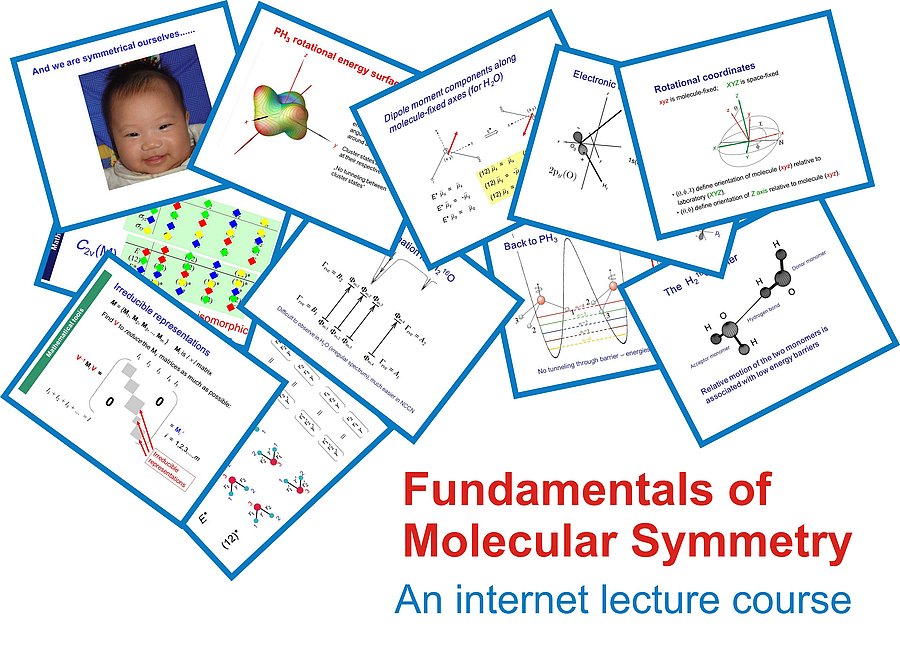
The lectures introduce group theory with special emphasis on representations and their use in describing the symmetry of molecules in theoretical chemistry and in molecular physics generally. The theory is accompanied by a series of “prototypical” examples, mostly concerned with applications of symmetry principles in high-resolution molecular spectroscopy.
Contact: Prof. Per Jensen, Ph.D., jensen{at}uni-wuppertal.de
No further video conferences planned at the moment.
This course is planned in the classical, so-called 2+1 format of German universities: a 90-minute lecture session and a 45-minute exercise session per week for 11 weeks.
The exercise session should be taught by a ‘local’ ‘lab instructor’, for whom solutions to the exercise problems will be provided. For each of the 11 weeks of the course, the following internet resources should be made available to the students:
• A video file with the lecture of the week.
• A pdf file with powerpoint slides shown during the week’s lecture.
• A sheet with the problems suggested for the exercise session of the week.
All files can be freely downloaded from the internet; the corresponding links are given below together with keywords for the individual lectures.
When the video files are being watched on the screen of an ordinary computer, the picture of the powerpoint slides is relatively small. It is conceivable that there will be occasional difficulties reading the smaller print directly from the video file. To circumvent this problem, we supply the pdf files generated from the powerpoint files. In my experience, these files are readable also on small screens. A few typographical problems were discovered as the lectures were recorded. I have generally tried to correct these in the pdf files generated from the powerpoint files. That is, for a few slides distributed over the 11 lectures, the layout in the pdf file is nicer and clearer than in the file used for the video recording. However, these changes are purely cosmetic, there has been no change of the informational content. In the same vein, I discovered two mistakes, one in Lecture 10 and one in Lecture 11, while giving these lectures and I pointed out the mistakes and corrected them with the red pen. These mistakes have been corrected in the pdf files.
Here follow a week-by-week overview of the lectures and the links to the associated files:
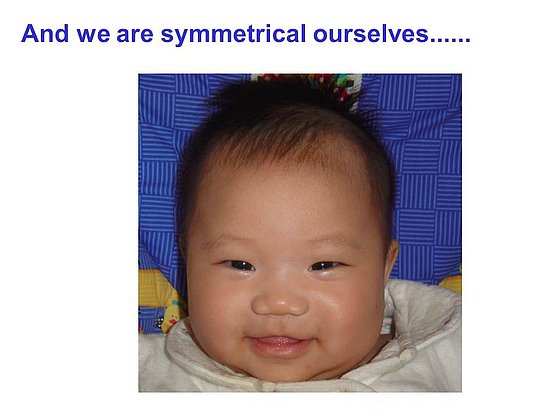
The concept of symmetry in everyday life, geometrical symmetry, symmetry in quantum mechanics, permutation-inversion symmetry, groups and symmetry groups.
| Video: | http://podcast.uni-wuppertal.de/wp-content/uploads/2014/01/Vorlesung1.mp4 |
| Slides: | http://www.chem.uni-wuppertal.de/theochem/FMS-lecture1.pdf |
| Exercises: | http://www.chem.uni-wuppertal.de/theochem/FMS_exercise_week1.pdf |
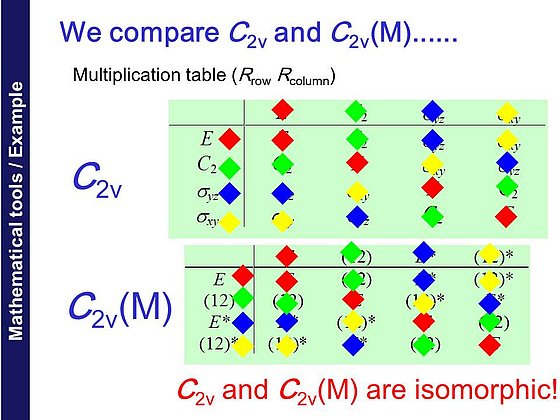
Permutation-inversion symmetry and groups continued, subgroups, isomorphism, homomorphism, classes, point groups, matrix groups, representations.
| Video: | http://podcast.uni-wuppertal.de/wp-content/uploads/2014/01/Vorlesung2.mp4 |
| Slides: | http://www.chem.uni-wuppertal.de/theochem/FMS-lecture2.pdf |
| Exercises: | http://www.chem.uni-wuppertal.de/theochem/FMS_exercise_week2.pdf |
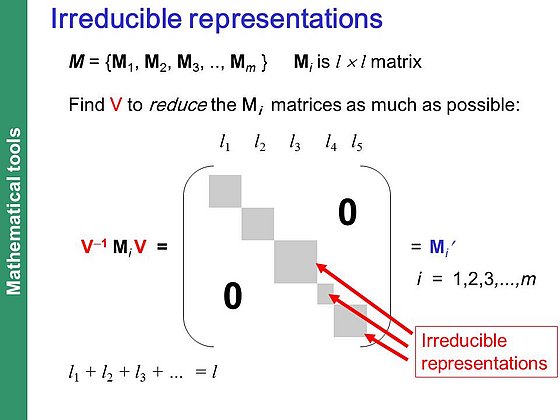
Equivalent representations, characters, characters and classes, irreducible representations, determination of irreducible representations.
| Video: | http://podcast.uni-wuppertal.de/wp-content/uploads/2014/01/Vorlesung3.mp4 |
| Slides: | http://www.chem.uni-wuppertal.de/theochem/FMS-lecture3.pdf |
| Exercises: | http://www.chem.uni-wuppertal.de/theochem/FMS_exercise_week3.pdf |
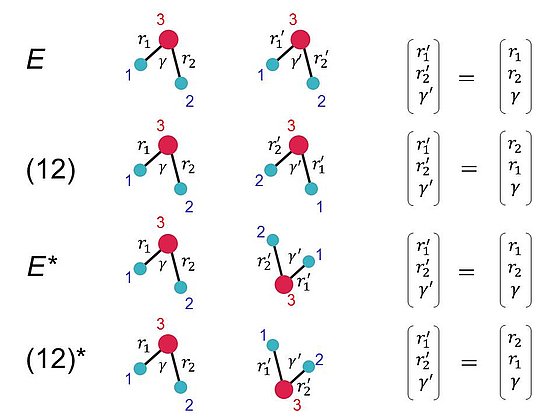
Irreducible representations continued, generation of representations, reduction of representations, effect of a symmetry operation on a wavefunction.
| Video: | http://podcast.uni-wuppertal.de/wp-content/uploads/2014/01/Vorlesung4.mp4 |
| Slides: | http://www.chem.uni-wuppertal.de/theochem/FMS-lecture4.pdf |
| Exercises: | http://www.chem.uni-wuppertal.de/theochem/FMS_exercise_week4.pdf |
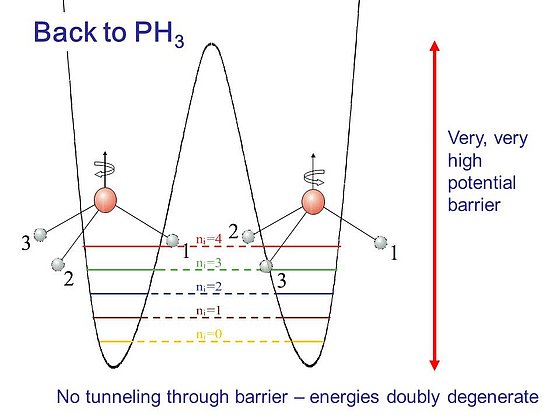
The molecular Hamiltonian and its symmetry, symmetry classification for non-degenerate and degenerate molecular states, the Complete Nuclear Permutation-Inversion Group, feasibility, the Molecular Symmetry (MS) Group, isomorphism of MS group and point group at equilibrium for rigid molecules.
| Video: | http://podcast.uni-wuppertal.de/wp-content/uploads/2014/01/Vorlesung5.mp4 |
| Slides: | http://www.chem.uni-wuppertal.de/theochem/FMS-lecture5.pdf |
| Exercises: | http://www.chem.uni-wuppertal.de/theochem/FMS_exercise_week5.pdf |
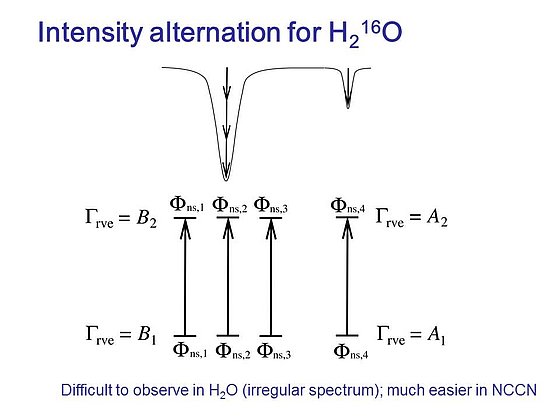
Nonrigid molecules, nuclear spin statistical weight factors.
| Video: | http://podcast.uni-wuppertal.de/wp-content/uploads/2014/01/Vorlesung6.mp4 |
| Slides: | http://www.chem.uni-wuppertal.de/theochem/FMS-lecture6.pdf |
| Exercises: | http://www.chem.uni-wuppertal.de/theochem/FMS_exercise_week6.pdf |
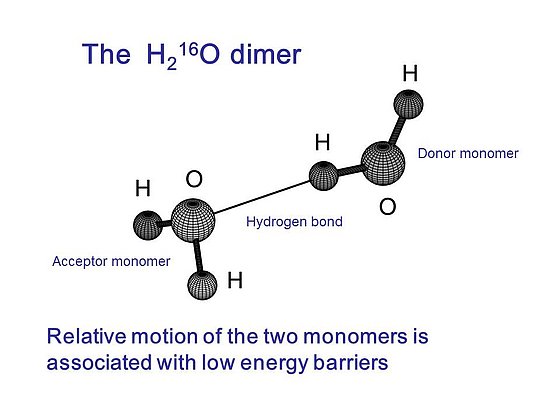
Hyperfine structure, forward and reverse correlation.
| Video: | http://podcast.uni-wuppertal.de/wp-content/uploads/2014/01/Vorlesung7.mp4 |
| Slides: | http://www.chem.uni-wuppertal.de/theochem/FMS-lecture7.pdf |
| Exercises: | http://www.chem.uni-wuppertal.de/theochem/FMS_exercise_week7.pdf |
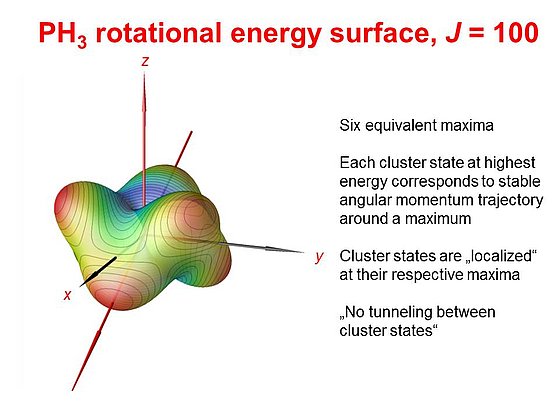
Energy level cluster formation, vanishing integral rule, symmetry of a product, optical selection rules.
| Video: | http://podcast.uni-wuppertal.de/wp-content/uploads/2014/01/Vorlesung8.mp4 |
| Slides: | http://www.chem.uni-wuppertal.de/theochem/FMS-lecture8.pdf |
| Exercises: | http://www.chem.uni-wuppertal.de/theochem/FMS_exercise_week8.pdf |
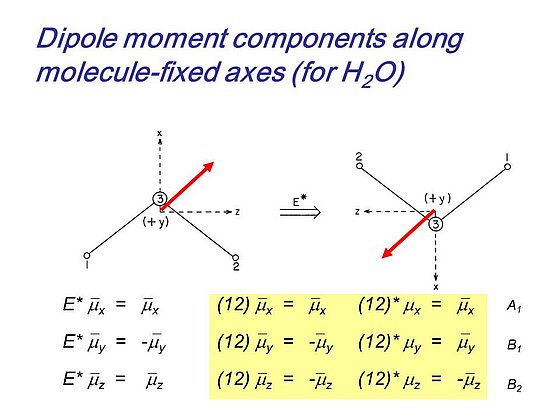
Optical selection rules continued, the molecular wavefunction.
| Video: | http://podcast.uni-wuppertal.de/wp-content/uploads/2014/01/Vorlesung9.mp4 |
| Slides: | http://www.chem.uni-wuppertal.de/theochem/FMS-lecture9.pdf |
| Exercises: | http://www.chem.uni-wuppertal.de/theochem/FMS_exercise_week9.pdf |
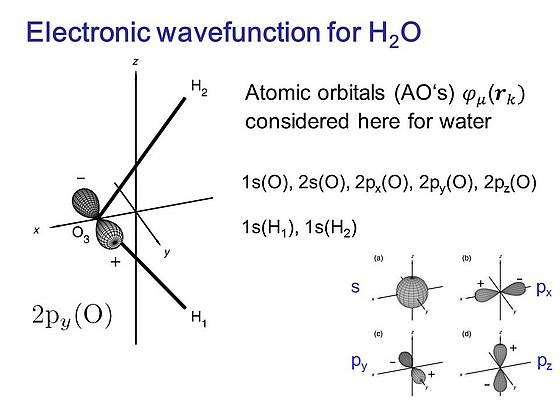
Electronic wavefunctions and their symmetries, vibrational wavefunctions and their symmetries.
| Video: | http://podcast.uni-wuppertal.de/wp-content/uploads/2014/01/Vorlesung10.mp4 |
| Slides: | http://www.chem.uni-wuppertal.de/theochem/FMS-lecture10.pdf |
| Exercises: | http://www.chem.uni-wuppertal.de/theochem/FMS_exercise_week10.pdf |
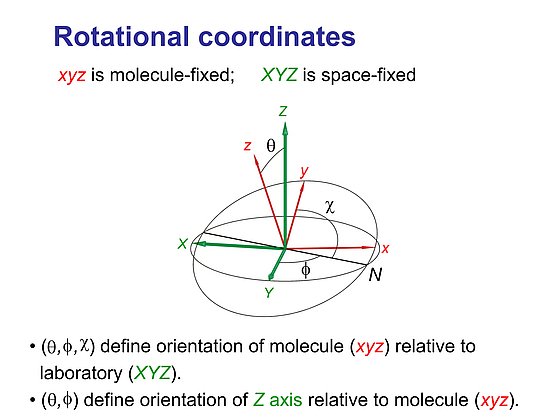
Rigid (static) rotor wavefunctions and their symmetries, rotational selection rules.
| Video: | http://podcast.uni-wuppertal.de/wp-content/uploads/2014/01/Vorlesung11.mp4 |
| Slides: | http://www.chem.uni-wuppertal.de/theochem/FMS-lecture11.pdf |
| Exercises: | http://www.chem.uni-wuppertal.de/theochem/FMS_exercise_week11.pdf |
The recommended literature for this lecture course are the two monographs on the subject by Bunker and Jensen together with the review article in “Encyclopedia of Chemical Physics and Physical Chemistry”:
· P. R. Bunker and P. Jensen: “Molecular Symmetry and Spectroscopy, 2nd Edition,” NRC Research Press, Ottawa, 1998 (ISBN 0-660-17519-3).
· P. Jensen and P. R. Bunker: The Symmetry of Molecules, in: “Encyclopedia of Chemical Physics and Physical Chemistry” (J. H. Moore and N. D. Spencer, Eds.), IOP Publishing, Bristol, 2001.
· P. R. Bunker and P. Jensen: “Fundamentals of Molecular Symmetry,” IOP Publishing, Bristol, 2004 (ISBN 0-7503-0941-5).
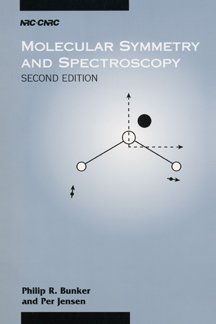
“Molecular Symmetry and Spectroscopy, 2nd Edition” is at a level appropriate for graduate students and researchers in molecular sciences. It is now out of regular print but an e-book version is available from NRC Research Press, see http://www.nrcresearchpress.com/doi/book/10.1139/9780660196282, and print-on-demand paper books are available from the company Volumes (in Kitchener, Ontario, Canada), see https://volumesdirect.com/products/molecular-symmetry-and-spectroscopy?_pos=1&_sid=ed0cc0319&_ss=r
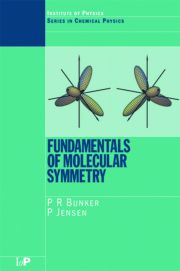
“Fundamentals of Molecular Symmetry” is an introductory text, suitable for students starting out in the field. It is in regular print, see http://www.crcpress.com/product/isbn/9780750309417.
The review article in “Encyclopedia of Chemical Physics and Physical Chemistry” is a highly condensed presentation of the theory covered in the lecture; it may also be useful for readers starting out in the field.
The lectures in this series have reached their present form through writing and teaching activities taking place over a period of many years. Many of these activities involved collaboration with my erstwhile Ph.D. supervisor, Dr. Phil(ip R.) Bunker (National Research Council of Canada, Ottawa), and I thank him for introducing me to the subject of molecular symmetry now more than 30 years ago and inviting me to join him in extending the first edition of “Molecular Symmetry and Spectroscopy.”
The first time I gave a complete lecture course on this subject was in the Winter Term 2002/2003 at the University of Cologne. This course took place at the initiative of the late Professor Gisbert Winnewisser, for whose enthusiastic support I am grateful. The exercises accompanying these first lectures were led by (present-day) Drs. Petra Neubauer-Guenther and Guido Fuchs, whose assistance with the preparation of the exercise problems was very helpful. (Present-day) Drs. Oliver Baum and Monika Körber gave similar help at later times.
During the present millennium, I have had the pleasure of being invited to teach this lecture course, or parts of it, at several locations away from Wuppertal. I thank the various colleagues who invited me for this and have endeavoured to remember them all: Professor Štěpán Urban (Vysoká Škola Chemicko-Technologická v Praze, Prague), Professors Stephan Schlemmer and Thomas Giesen (Universität zu Köln), Professor Pedro Gómez Calzada (Universidad Complutense, Madrid), Professors Keiko Takano and Keiko Miyamoto (Ochanomizu University, Tokyo), Professors Miguel Carvajal Zaera and Francisco Pérez-Bernal (Universidad de Huelva), Professors Rafael Escribano and Victor Herrero (Consejo Superior de Investigaciones Científicas, Madrid), and Professor Takayoshi Amano (then at Ibaraki University in Mito).
Some slides in the powerpoint presentations were originally prepared by (present-day) Drs. Sergei N. Yurchenko, Miguel Carvajal Zaera, and Vladlen V. Melnikov – I thank them for this. I also thank Professor Hai Lin (University of Colorado at Denver) for permission to use the picture of his baby daughter to illustrate the point of human beings having geometrical near-symmetry.
The present electronic version of the lecture course has been prepared through the efforts of Messrs. Marc Stania, Hubertus Knopff, and Uli Christmann of the Zentrum für Informations- und Medienverarbeitung (ZIM) at the University of Wuppertal. I am very grateful to these three gentlemen, to the director of ZIM Mr. Dieter Huth, and to M.Sc. Saskia Springmann for being a highly active member of the audience, whose constructive suggestions for improvements of the lectures were very valuable.
I thank in advance Professors Thomas Giesen (now at the University of Kassel) and Stephan Schlemmer (Universität zu Köln) for them kindly giving me the opportunity to try out the electronic version of the lecture course at their respective institutions.
Wuppertal, January 2014
Per Jensen
Prof. Dr. Thomas Giesen, Department of Laboratory Astrophysics, Institute of Physics, University of Kassel, Germany
Students of physics (MSc) at the University of Kassel have been able to deepen their knowledge in the field of astrophysics since 2012. Among other things, a two-semester lecture on laboratory astrophysics is offered, in which the basics of molecular physics and its application in astrophysics are taught. After an introduction to molecular physics (Laboratory Astrophysics I), Laboratory Astrophysics II is followed by an in-depth study of the methods used to characterize molecules using molecular symmetries. I asked Prof. Per Jensen to give a block lecture in Kassel because he is a proven expert in the field of molecular symmetries and a gifted teacher whose technical competence and didactic methodology I had convinced myself of in a series of lectures, summer schools, seminars and discussions. His offer to do this in the form of a weekly video lecture and an accompanying practice lesson directly met with my approval, as a weekly event is much better suited to the dense curriculum of the students than a block event. The lecture "Fundamentals of Molecular Symmetry" by Prof. Jensen was offered to students weekly as a recording in the summer semester 2014. The video was stopped when students asked questions and answers were given as soon as possible by the trainer, Mrs. Herberth, or by me. Prof. Jensen provided accompanying exercises for each lecture, which the students tried to solve independently. The solutions to the tasks were discussed with the trainer and could be discussed directly "live" with Prof. Jensen in a two-week video conference between Kassel and Wuppertal.
In terms of content and didactics, the lecture is of the highest quality. The clearly structured and easily comprehensible mathematical methods on the one hand and the multitude of explanatory examples on the other have contributed greatly to the understanding of the subject matter. In addition, the choice and use of terms is consistent throughout the lecture, which further contributes to understanding. Thanks to the excellent exercises, on the one hand the acquired knowledge can be consolidated and on the other hand ambiguities can be better named and then further discussed in the online question and answer session. The lecture was well attended with 10-12 students. It was also gratifying that not a single student had prematurely cancelled the lecture.
Naturally, the increasing specialisation of the range of lectures brings with it a smaller number of listeners per lecture. In order to be able to offer a wide range of courses at a high level, online lectures read by experts in their field are a suitable means of improving teaching. The lecture "Fundamentals of Molecular Symmetry" by Prof. Jensen shows this new teaching concept in impressive clarity and beauty and encourages imitation. I hope this won't be the only video lecture by Prof. Jensen.
Prof. Dr. Thomas Giesen
December 2014
Prof. Dr. Stephan Schlemmer, 1st Institute of Physics, University of Cologne, Germany
In the summer semester 2014 we offered the lecture Molecular Physics II (molecular symmetry) and made use of the online lecture "Fundamentals of Molecular Symmetry - An Internet Lecture" by Prof. Per Jensen. Here I describe the very positive experiences with this form of teaching after presenting the integration of the lecture into our teaching concept.
The lecture Molecular Physics II (molecular symmetry) is the second part of a lecture dealing with the topic Molecular Physics, one of the seven major subjects of the Master's Program in Physics in Cologne. In the first semester, the main focus is on chemical binding in diatomic molecules. First the electronic problem (Born-Oppenheimer approximation) is solved and then the vibration rotation problem. At the end of the first semester, the rotation problem of the non-rigid polyatomic molecule is considered. In the lecture Molecular Physics II the vibration of polyatomic molecules is considered.
The Online Lecture Fundamentals of Molecular Symmetry - An Internet Lecture by Prof. Jensen fits perfectly into our desired teaching concept. Students are introduced to molecular symmetry in a very compact way. The topic plays a certain role in physics education already within the framework of mathematics education. However, the usefulness of the concepts of linear algebra remains largely hidden. Molecular symmetry is a unique opportunity to use the instruments of mathematics to solve simple as well as complex problems in molecular physics. Prof. Jensen succeeds in bridging the gap between the view, mathematical tools and their application in molecular physics in an outstanding way. In the process, mathematical ballast is deliberately dispensed with. Some physics students, however, can fall back on the basic education in B.Sc. here. However, this is not necessary to understand the lecture.
The lecture covers all important topics of molecular symmetry and their effect on various problems of molecular physics. Particularly attractive is the basic principle of permutation-inversion symmetry, which, in contrast to the conventional theory of point groups of molecular symmetries, is not based on the geometric symmetry of the molecules, but on the symmetry of the energy operator and therefore allows the treatment of quite flexible molecules. Thus, the content of the lecture fits perfectly into the wishes of the education of the local physics students. Students benefit in many ways from the fact that this lecture is taught by one of the leading scientists in the field, Prof. Per Jensen, as the deep understanding of the demanding matter is presented in an appropriate manner. Prof. Jensen knows exactly which points will be needed later in the lecture and thus doses the proportion of mathematical basics with regard to the corresponding applications in an optimal way. This makes the lecture an optimal tool in our training. In the past we therefore invited Prof. Jensen to block events where he taught the essence of the lecture which is now available online.
The concept of the online lecture has other very positive aspects. Students can view or repeat the lecture at any time. This flexibility reduces the risk of cancellation of the course, e.g. in case of illness of the student during the semester. The connection between study and family is also made easier. Despite this offer, the students (6-9) mostly took advantage of the fixed lecture date. As the person responsible for the event, I was always present at the lectures and was thus able to get an impression of whether the students were able to cope with the material and possibly answer further questions. This was only an offer for a first realization of the event. It has been shown that the lecture can be followed well. The possible question time with Prof. Jensen is another good offer for the students. Another very important element in the event is the practice operation. In the summer semester 2014 the exercise held an experienced doctoral student. In consultation with the students, the exercises could be placed in a suitable place in the weekly calendar. The exercises were very well received. In the combination of lecture (demonstration by the trainer) and practice (with questions from the lecture) the event has the same quality as a live event. We intend to make the online lecture an integral part of the training in Cologne.
In conclusion, we would like to express our sincere thanks to Prof. Jensen, who has rendered outstanding services to the topic and the students. If you follow the events with a lot of previous knowledge, you can estimate how much work there is in this material. I am sure I can say that only a few teachers would be able to prepare and present the material in such a suitable way. Prof. Jensen succeeded in a brilliant way. In my opinion, it is clear that this type of event is an ideal way to present the necessary specialist knowledge to a circle of interested students. For listeners of a location the expenditure is certainly very high. However, if you consider which group of people Prof. Jensen has already reached within a semester, the work is certainly justified. In addition, such an effort is also worthwhile for the home university, because the name of the university is also associated with the name of the excellent teacher. Therefore, any institution should consider itself fortunate to have teachers among it who provide such an exceptional service.
Prof. Stephan Schlemmer
December 2014